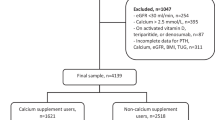Abstract
Purpose
Recurrent kidney stones are associated with bone mineral density loss, altered bone remodeling markers, hypercalciuria and increased in fasting calcium/creatinine ratio. The objective was to determine biochemical alterations in urine in patients with osteopenia/osteoporosis without calcium kidney stones compared with patients with calcium kidney stones.
Methods
This is a cross-sectional study including 142 patients who were divided in two groups: Group 1 (patients with recurrent calcium kidney stones) and Group 2 (patients with osteopenia/osteoporosis in the lumbar spine or hip). Analyses of bone mineral density, calcium–phosphorous and bone metabolism and lithogenic risk factors in fasting urine samples and 24-h urine samples were performed. Statistical analysis was carried out with SPSS 17.0. A p ≤ 0.05 was considered statistically significant.
Results
Patients in Group 2 presented greater loss of bone mineral density and more elevated alkaline phosphatase, iPTH, phosphorous and β-crosslaps levels, as compared to patients in Group 1. However, Group 1 presented greater urine calcium, oxalate and uric acid and a higher proportion of hypocitraturia, hypercalciuria and hyperoxaluria, as compared to Group 2. Multivariate analysis revealed that advanced age and β-crosslaps levels are risk factors for bone mineral density loss, while low urinary calcium excretion was protective against bone demineralization.
Conclusion
Patients with osteopenia/osteoporosis without lithiasis present some urinary biochemical alterations. This would explain the lack of lithogenic activity, although low calcium excretion in 24-h urine samples is a protective factor against the loss of bone mineral density.

Similar content being viewed by others
Notes
Determined by schimioiluminescence using the automatic analyzer LIAISON-Osteocalcin (DIASORIN).
Determined by schimioiluminescence immunoassay “ECLIA” using the automatic analyzer Elecsys MODULAR ANALYTICS E170—(Roche Diagnostic).
References
Arrabal Polo MA, Arrabal Martín M, De Haro Muñoz T et al (2011) Mineral density and bone remodeling markers in patients with calcium lithiasis. BJU Int 108:1903–1908
Tasca A, Cacciola A, Ferrarese P et al (2002) Bone alterations in patients with idiopathic hypercalciuria and calcium nephrolithiasis. Urology 59:865–869
Caudarella R, Vescini F, Buffa A et al (2003) Bone mass loss in calcium stone disease: focus on hypercalciuria and metabolic factors. J Nephrol 16:260–266
Lauderdale DS, Thisted RA, Wen M et al (2001) Bone mineral density and fracture among prevalent kidney stone cases in the Third National Health and Nutrition Examination Survey. J Bone Miner Res 16:1893–1898
Kuczera M, Wiecek A, Kokot F (1997) Markers of bone tumover in patients with nephrolithiasis. Int Urol Nephrol 29:523–529
Asplin JR, Donahue S, Kinder J et al (2006) Urine calcium excretion predicts bone loss in idiopathic hypercalciuria. Kidney Int 70:1463–1467
Letavernier E, Traxer O, Daudon M et al (2011) Determinants of osteopenia in male renal-stone–disease patients with idiopathic hypercalciuria. Clin J Am Soc Nephrol 6:1149–1154
Arrabal Polo MA, Arrabal Martín M, De Haro Muñoz T et al (2012) Biochemical determinants of severe lithogenic activity in patients with idiopathic calcium nephrolithiasis. Urology 79:48–54
Arrabal Polo MA, Arrabal Martin M, Poyatos Andujar A et al (2012) Is the fasting calcium/creatinine a bone resorption marker in patients with calcium renal stones? Urol Res 40:243–245
Arrabal Polo MA, Arrabal Martín M, Giron Prieto MS et al (2012) Osteopenia/osteoporosis in patients with calcium nephrolithiasis. Urol Res 40:709–716
Arrabal Polo MA, Arias Santiago S, Arrabal Martín M (2012) What is the value of bone remodeling markers in patients with calcium stones? Urol Res 40:803
Arrabal-Polo MÁ, Sierra Girón-Prieto M, Orgaz-Molina J et al (2013) Calcium renal lithiasis and bone mineral density. Importance of bone metabolism in urinary lithiasis. Actas Urol Esp 37:362–367
Arrabal Polo MA, Arrabal Martin M, Arias Santiago S et al (2013) Importance of citrate and the calcium: citrate ratio in patients with calcium renal lithiasis and severe lithogenesis. BJU Int 111:622–627
Caudarella R, Vescini F, Buffa A et al (2004) Osteoporosis and Urolithiasis. Urol Int 72(suppl 1):17–19
Ryan LE, Ing SW (2012) Idiopathic hypercalciuria and bone health. Curr Osteoporos Rep 10:286–295
Asplin JR, Bauer KA, Kinder J et al (2003) Bone mineral density and urine calcium excretion among subjects with and without nephrolithiasis. Kidney Int 63:662–669
Tsuji H, Umekawa T, Kurita T et al (2005) Analysis of bone mineral density in urolithiasis patients. Int J Urol 12:335–339
Arrabal Polo MA, Arrabal Martin M, Arias Santiago S et al (2012) Metabolic-mineral study in patients with renal calcium lithiasis, severe lithogenic activity and loss of bone mineral density. Singap Med J 53:808–813
Arrabal Polo MA, Arrabal Martin M, Giron Prieto MS et al (2013) Association of severe calcium lithogenic activity and bone remodeling markers. Urology 82:16–21
Moyano MJ, Gómez de Tejada MJ, García Lozano R et al (2007) Alteraciones en el metabolismo mineral óseo en pacientes con urolitiasis de repetición y polimorfismos del gen del receptor de la vitamina D. Resultados preliminares. Nefrologia 27:694–703
Bilic-Curcic I, Milas-Ahic J, Smolic M et al (2009) Urolithiasis and osteoporosis: clinical relevance and therapeutic implications. Coll Antropol 33(2):189–192
Krieger NS, Bushinsky DA (2013) The relation between bone and stone formation. Calcif Tissue Int 93:374–381
Acknowledgments
This article is part of Doctoral Thesis of María de la Sierra Giron-Prieto. This article and investigation has been funded by Fundación Progreso y Salud. Junta de Andalucía. PI 0766/2013.
Conflict of interest
The authors declare no conflict of interest.
Author information
Authors and Affiliations
Corresponding author
Rights and permissions
About this article
Cite this article
Arrabal-Martin, M., Poyatos-Andujar, A., del Carmen Cano-García, M. et al. The importance of calciuria as lithogenic factors in patients with osteopenia/osteoporosis. Int Urol Nephrol 47, 445–449 (2015). https://doi.org/10.1007/s11255-015-0918-z
Received:
Accepted:
Published:
Issue Date:
DOI: https://doi.org/10.1007/s11255-015-0918-z




